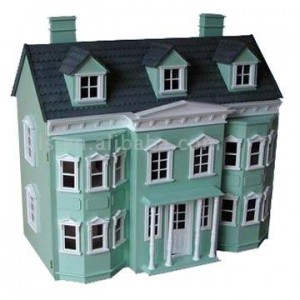My Dollhouse, Myself: Miniature Histories
By Nicole Cooley
In the Dollhouse Nursery
Painted sea foam green, the nursery you arrange on the top floor of your dollhouse has enough space for a gallery of beds—single cots with sheets stretched tight, wrought iron cribs, satin-quilted bassinets. So many babies.
Think Hospital. Think Orphanage.
In this world, you don’t have a body, but you can have as many children as you want. No one will grow up.
Tuck your daughters inside the comforters you made from cotton in a ring box.
Hide your smallest baby in a walnut shell for safekeeping.
Tell yourself a lie. You are a mother. You are the author of this house.
Chicago, 1952
“Swallow the medicine without spitting it out, and I’ll give you a dresser,” Eddie tells my mother and her sister.
Jacki and Janice are sick, and they are confined to bed, in the bedroom they share with their grandmother. The girls are eight and six.
The sisters have chickenpox and are under quarantine, not allowed to leave the house, not allowed to get out of bed. If they drink the bitter medicine four times a day, furniture for their dollhouse is their reward. Uncle Eddie invented the system: four times a day, Eddie holds a medicine bottle in one hand and a Marshall Fields box full of dollhouse furniture in the other.
Today he is offering a tiny metal three-drawer dresser and a wing chair.
The dollhouse furniture is irresistible, which is of course the point. The girls’ dollhouse sits on a table across the room though they are not allowed to get out of bed and play with it while they are sick. But they can save the Marshall Fields’ furniture for the future.
My mother’s family is first-generation American, from Austria, Hungary and Russia. My grandmother and grandfather own the house, but many relatives live in it with them. My grandmother secured her middle class identity by buying the house. Eddie who did not buy the house was the one who bought the dollhouse.
Where is my grandmother? She has no role in the dollhouse furniture routine.
My grandmother is not in the house because she is working. She is running the lumberyard my grandparents own because my grandfather is not well enough to work. As a first generation American woman running a lumberyard in Chicago, my grandmother is very unusual.
Years later, when I am in my twenties, well-schooled in my college women’s studies classes, I will try to tell my grandmother that she is a pioneer. She will look at me with disbelief as I am a fool and shake her head. I do not understand, she tells me. She will say that she was not trying to be a career woman—the role I most want to assign her in the family narrative —because she had no choice. She had a family, a large family. She had children, a mother, brothers living at home. She had a husband who was sick. She had to work.
But, now, Uncle Eddie, who isn’t yet married and doesn’t yet have any children, has brought dollhouse play into the house, where he lives with the large extended family, including the girls, their parents, his brothers, and his mother, my great-grandmother Rose.
Kept beside their beds, the girls’ fiberboard dollhouse was painted white with green shutters like most American dollhouses from the 1920s to the 1960s, but it also had a California-style sundeck. The girls set their dolls in beach chairs on the sundeck in the middle of a Chicago winter.
In this dollhouse, there is a plastic family of four: a mother, father and two children, a middle class 1950s family, the kind the girls have watched on television. The dollhouse daughters do not share a room and sleep in a bed with their grandmother, as my mother and her sister do. The dollhouse couches are not covered in plastic to keep them safe, no one cooks strudel and goulash and noodle casserole with cottage cheese in the dollhouse kitchen. No one whispers prayers over her Croatian Bible at night.
The dollhouse furniture Eddie gives the girls will help them make an entirely new life, one that has nothing to do with their immigrant past.
Here is the Marshall Fields box.
Here is a dining table. Here is a bathroom sink. Here is a loaf of fake rubber bread.
Swallow it down.
Dollhouse as medicine. Dollhouse as antidote. One piece for each spoonful.
Here is a dining table.
The dollhouse is my mother’s first step towards walking away from this life.
Marriage
“A dollhouse is a house that never leaves you,” Barb McGee tells me as we stand at the counter. I am visiting McGees Miniatures, Barb’s dollhouse store, in a half-closed down, nearly empty mall at the edge of St. Louis.
I have questions I don’t ask: How could a house leave a person? Wouldn’t a person leave a house?
Barb pauses then continues. “If your husband doesn’t like your dollhouse, if it comes down to the house or the man, the dollhouse stays, and the man can move out.”
I want to know why a husband would want a dollhouse gone. Is the husband jealous of his wife’s escape into the fantasy world of a dollhouse, an escape in which he has no part? What does a dollhouse give a wife that a husband can’t?
I like the idea of a dollhouse as illicit, as hidden, as clandestine, as wrong.
I like the notion of a dollhouse as a secret lover.
The Miniature Birth Scene from Merida
On my desk at home, the miniature birth scene is a glass box, smaller than a soup can.
The scene is a hospital room, walls painted sky blue. There are four figures, all skeletons, all from the Day of the Dead: a doctor, a nurse, a mother and a baby. A bald skeleton doctor and a nurse with blacked out eyes, dressed in surgical scrubs, are in charge. A naked woman lies on a table, legs spread, her body half-covered by a piece of ripped up paper towel. From between her legs a tiny skeleton baby half emerges, head first, surrounded by deep red painted blood.
Nothing is idealized in the Miniatura Folklorica, where Day of the Day icons populate the landscape of tiny things. The shop is crammed with Dead of the Dead sugar skulls and six inch masked skeletons, and with miniature scenes, in glass boxes, all showing Death approaching. The miniature birth scenes are no exception. Instead of the way we so often wrongly depict birth in the US, as a joyful event, here birth is a scene of horror.
I was riveted by the birth scenes. I could not stop looking at them, studying them from all angles. I had to buy one to bring home.
The births of my own daughters were difficult and frightening beyond what I ever understood childbirth could be. Instead of drug-free labors and babies given to me to hold minutes after birth and joyous first days with my children, I was alone and scared in a hospital room for days without them. My first birth was an emergency c-section following hours of fruitless labor, followed by complications for my daughter and brain and heart tests performed on a newborn I had seen and never held for three minutes; the second was another c-section with more complications and my second baby taken away to the NICU and I did not see her for 24 hours after the birth. Both experiences felt far less than bringing a new life into the world than invasive medical experiences where all of us involved nearly died.
I loved that the miniature birth scenes told the truth about what birth was like.
But this was not the only reason I was so drawn to them.
The tiny glass boxes captured a moment I had not seen dramatized before. The miniature birth scene freezes time at the exact moment before motherhood starts. Or it freezes time so that motherhood will never begin. The baby is born but not born.
Is this the best moment of motherhood? Made miniature, made small enough to fit in a box? Made frozen in the way that only small static things can stop time. Baby born yet not born. Forever and ever, the baby stays half emerging, connected its skeleton mother and yet not. Born and yet never.
Henri Bendel’s New York City Holiday Windows
Walking too quickly past Bendel’s on a late winter afternoon, I almost miss it.
In the department store window on Fifth Avenue, a red headed dollhouse doll is texting.
She is six inches tall.
In her dollhouse — which is the store window — she reclines on her bed, with a look of deep concentration, furiously typing a tiny, invisible message into her phone. Another doll lies in a bathtub full of fake bathwater. Two other dolls listen to records and watch TV. The windows show the inside of six apartments, set up like dollhouses, with city backgrounds made by pop-up artist Robert Sabuda: a skyscape view of the Brooklyn Bridge, a fleet of miniature taxis rushing by.
Standing in front of Bendel’s, a store where I could never afford to shop, a store I’ve never entered, the power of the miniature world is enormous. It quite literally stops me in my tracks. I stand and stare at the windows.
Now I’m late to get home from work, I’ve missed my train, my husband and children are waiting, my bag is heavy with papers to grade tonight, I’m hungry, I’m tired, and all I want is to slip inside this magic dollhouse world in the window.
I want to dissolve, to turn into this single girl with a small silver phone, lounging in a bath, in my own studio apartment. I’ll tumble down a rabbit hole into a glamorous New York City life I’ve never lived.
All my life I’ve struggled to shrink my body. For every minute I can remember, I have wanted to be smaller. I’ve counted calories, I’ve manically exercised. I’ve measured myself with a tape measure from the hardware store and secretly recorded the statistics on my body, width of arm and wrist and waist. I’ve recorded lists of everything I ate each day and added it up, none of this unusual behavior for a girl growing up in the seventies and eighties.
But a dollhouse—and this particular dollhouse world on the late afternoon freezing streets of New York City—lets all of the work of trying to be small drop away. This dollhouse transports me to a place where I am instantly, beautifully tiny. The perfect size.
Or even better: in this store window if I stand here watching, if I stand here perfectly still, if I stand here long enough, I don’t have to have a body at all.
New Orleans, 1978
When I looked out the window of the bedroom I shared with my sister, Galvez Street brimmed with water as if our neighborhood were a mixing bowl. The drainage pumps failed. The rain, which had fallen for days, would not stop. The city shut down. The city filled with dirty, muddy water and no one, nothing, could stop it.
Inch by inch, then foot by foot, floodwater rose in the basement of our house.
My sister Alissa and I stood in the kitchen, at the top of the basement stairs, watching the dollhouse. Water rose up to the table where I kept my dollhouse, swirled around the contact paper cobblestone path that circled the house, around the electric light boxes on the sides of the house, but the interior of the house, all six rooms that my mother and I had decorated, painted shiny enameled pink, stayed dry and safe.
“Stay upstairs,” my mother told us “The water’s too dangerous. Take care of your sister.” She and my father spent days downstairs with buckets, mops and sponges. In the basement, the water was a foot deep – I knew my mother couldn’t be worried that we would drown — but like all floodwater it was a toxic stew of chemicals and run-off from the street. My sister and I sat in the living room and waited for news of our dollhouse.
For three days, rain had drenched the city, and its force was enough to flood the lower-lying neighborhoods like ours, in the Broadmoor district. We lived far from the river, but the city routinely filled to the brim with water whenever there was a bad storm. The flood ruined my family’s possessions we had stored there, our suitcase, our boxes of books, photographs and papers. For a week, my parents stayed up late in the basement every night, throwing away soaked cardboard boxes and piling our ruined possessions into garbage bags. The dollhouse was the only object in our basement on Galvez Street to survive the flood.
The 1978 flood was nothing like the flood that would come later, the flood that would drown New Orleans in August 2005, leaving the whole city underwater. The levees did not break. The river did not crack the floodwalls. Now that I am adult, I can imagine what these days were like for my parents, doing the grim work of mopping and cleaning a basement in a house that did not belong to them, while realizing their own belongings that they thought were safe in boxes and on shelves were destroyed. But at the time all I cared about, with typical childhood selfishness, was my dollhouse.
Nothing could be saved.
Except the dollhouse.
To me, the dollhouse surviving dry and intact was proof of its magic. And of my mother’s magic and her ability to control the world: she’d built me my own house, which I believed would never be destroyed. My mother made me a perfect miniature universe that stayed safe when the rest of the world collapsed.
______________________________________________
 Nicole Cooley grew up in New Orleans and now lives outside of NYC. She is the author of four books of poems, most recently Breach (LSU Press) and Milk Dress (Alice James Books), both published in 2010, as well as a novel published by Harper Collins in 1998. She is the director of the MFA program in creative writing and literary translation at Queens College-City University of New York. This piece is from her non-fiction book, My Dollhouse, Myself: Miniature Histories.
Nicole Cooley grew up in New Orleans and now lives outside of NYC. She is the author of four books of poems, most recently Breach (LSU Press) and Milk Dress (Alice James Books), both published in 2010, as well as a novel published by Harper Collins in 1998. She is the director of the MFA program in creative writing and literary translation at Queens College-City University of New York. This piece is from her non-fiction book, My Dollhouse, Myself: Miniature Histories.




0 comments